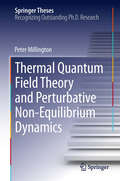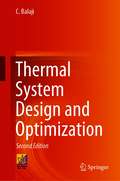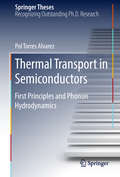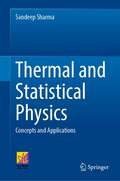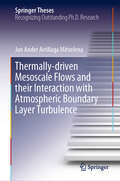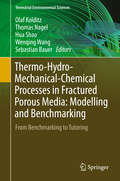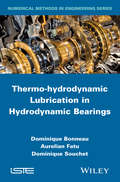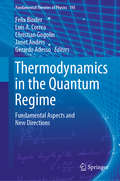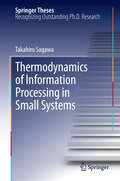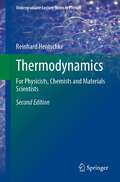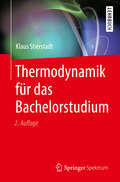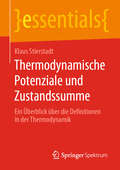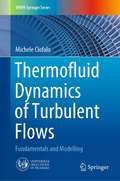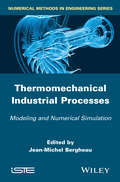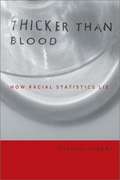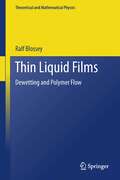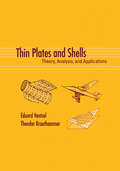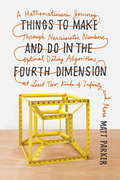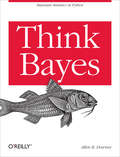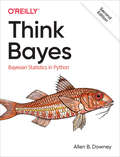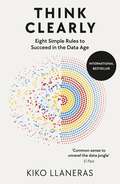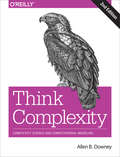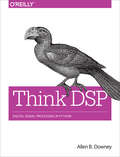- Table View
- List View
Thermal Quantum Field Theory and Perturbative Non-Equilibrium Dynamics
by Peter MillingtonThe author develops a new perturbative formalism of non-equilibrium thermal quantum field theory for non-homogeneous backgrounds. As a result of this formulation, the author is able to show how so-called pinch singularities can be removed, without resorting to ad hoc prescriptions, or effective resummations of absorptive effects. Thus, the author arrives at a diagrammatic approach to non-equilibrium field theory, built from modified Feynman rules that are manifestly time-dependent from tree level. This new formulation provides an alternative framework in which to derive master time evolution equations for physically meaningful particle number densities, which are valid to all orders in perturbation theory and to all orders in gradient expansion. Once truncated in a loop-wise sense, these evolution equations capture non-equilibrium dynamics on all time-scales, systematically describing energy-violating processes and the non-Markovian evolution of memory effects
Thermal Spray Coatings: Fundamentals and Applications (Advanced Structured Materials #232)
by Santosh Kumar Chander Prakash Virat Khanna Swarn SinghThis book provides a comprehensive review of the effects of key factors ranging from powder characteristics to process parameters, substrate preparation, and post-treatment methods on the coated substrate surface by different thermal spray techniques. Thermal spray techniques have gained significant attention in various industries due to their ability to deposit protective coatings on substrates. These coatings enhance the surface properties of substrates, such as wear resistance, corrosion resistance, and thermal insulation. However, the quality and performance of the coated substrate surface are influenced by several key factors. The book discusses the influence of parameters such as powder characteristics, process parameters, substrate preparation, and post-treatment methods on the coating microstructure, adhesion, and overall performance. The review aims to contribute to a better understanding of the factors that affect the coated substrate surface and provide insights for future research and optimization of thermal spray processes.
Thermal System Design and Optimization
by C. BalajiThis highly informative and carefully presented textbook introduces the general principles involved in system design and optimization as applicable to thermal systems, followed by the methods to accomplish them. It introduces contemporary techniques like Genetic Algorithms, Simulated Annealing, and Bayesian Inference in the context of optimization of thermal systems. There is a separate chapter devoted to inverse problems in thermal systems. It also contains sections on Integer Programming and Multi-Objective optimization. The linear programming chapter is fortified by a detailed presentation of the Simplex method. A major highlight of the textbook is the inclusion of workable MATLAB codes for examples of key algorithms discussed in the book. Examples in each chapter clarify the concepts and methods presented and end-of-chapter problems supplement the material presented and enhance the learning process.
Thermal Transport in Semiconductors: First Principles and Phonon Hydrodynamics (Springer Theses)
by Pol Torres AlvarezStarting from a broad overview of heat transport based on the Boltzmann Transport Equation, this book presents a comprehensive analysis of heat transport in bulk and nanomaterials based on a kinetic-collective model (KCM). This has become key to understanding the field of thermal transport in semiconductors, and represents an important stride. The book describes how heat transport becomes hydrodynamic at the nanoscale, propagating very much like a viscous fluid and manifesting vorticity and friction-like behavior. It introduces a generalization of Fourier’s law including a hydrodynamic term based on collective behavior in the phonon ensemble. This approach makes it possible to describe in a unifying way recent experiments that had to resort to unphysical assumptions in order to uphold the validity of Fourier’s law, demonstrating that hydrodynamic heat transport is a pervasive type of behavior in semiconductors at reduced scales.
Thermal and Statistical Physics: Concepts and Applications
by Sandeep SharmaThis textbook presents the fundamental concepts and theories in thermal physics and elementary statistical mechanics in a very simple, systematic and comprehensive way. This book is written in a way that it presents the topics in a holistic manner with end-of-chapter exercises and examples where concepts are supported by numerous solved examples and multiple-choice questions to aid self-learning. The textbook also contains illustrated diagrams for better understanding of the concepts. The book will benefit students who are taking introductory courses in thermal physics, thermodynamics and statistical mechanics.
Thermally-driven Mesoscale Flows and their Interaction with Atmospheric Boundary Layer Turbulence (Springer Theses)
by Jon Ander Arrillaga MitxelenaThis book presents developments of novel techniques and applies them in order to understand the interactions between thermally driven mesoscale flows (sea and mountain breezes) and the turbulent exchange within the atmospheric boundary layer. These interactions are not accurately reproduced in the meteorological models currently employed for weather forecasting. Consequently, important variables such as air temperature and wind speed are misrepresented. Also, the concentrations of relevant greenhouse gases such as CO2 are considerably affected by these interactions.By applying a systematic algorithm based on objective criteria (presented here), the thesis explores complete observational databases spanning up to 10 years. Further, it presents statistically significant and robust results on the topic, which has only been studied in a handful of cases in the extant literature. Lastly, by applying the algorithm directly to the outputs of the meteorological model, the thesis helps readers understand the processes discussed and reveals the biases in such models.
Thermo-Hydro-Mechanical-Chemical Processes in Fractured Porous Media: From Benchmarking To Tutoring (Terrestrial Environmental Sciences Ser.)
by Thomas Nagel Olaf Kolditz Hua Shao Wenqing Wang Sebastian BauerThe book comprises the 3rd collection of benchmarks and examples for porous and fractured media mechanics. Analysis of thermo-hydro-mechanical-chemical (THMC) processes is essential to a wide area of applications in environmental engineering, such as geological waste deposition, geothermal energy utilization (shallow and deep systems), carbon capture and storage (CCS) as well as water resources management and hydrology. In order to assess the feasibility, safety as well as sustainability of geoenvironmental applications, model-based simulation is the only way to quantify future scenarios. This charges a huge responsibility concerning the reliability of conceptual models and computational tools. Benchmarking is an appropriate methodology to verify the quality and validate the concept of models based on best practices. Moreover, benchmarking and code comparison are building strong community links. The 3rd THMC benchmark book also introduces benchmark-based tutorials, therefore the subtitle is selected as “From Benchmarking to Tutoring”. The benchmark book is part of the OpenGeoSys initiative - an open source project to share knowledge and experience in environmental analysis and scientific computation. The new version of OGS-6 is introduced and first benchmarks are presented therein (see appendices).
Thermo-hydrodynamic Lubrication in Hydrodynamic Bearings
by Dominique Bonneau Aurelian Fatu Dominique SouchetThis Series provides the necessary elements to the development and validation of numerical prediction models for hydrodynamic bearings. This book describes the thermo-hydrodynamic and the thermo-elasto-hydrodynamic lubrication. The algorithms are methodically detailed and each section is thoroughly illustrated.
Thermodynamics in the Quantum Regime: Fundamental Aspects and New Directions (Fundamental Theories of Physics #195)
by Gerardo Adesso Felix Binder Luis A. Correa Christian Gogolin Janet AndersQuantum Thermodynamics is a novel research field which explores the emergence of thermodynamics from quantum theory and addresses thermodynamic phenomena which appear in finite-size, non-equilibrium and finite-time contexts. Blending together elements from open quantum systems, statistical mechanics, quantum many-body physics, and quantum information theory, it pinpoints thermodynamic advantages and barriers emerging from genuinely quantum properties such as quantum coherence and correlations. Owing to recent experimental efforts, the field is moving quickly towards practical applications, such as nano-scale heat devices, or thermodynamically optimised protocols for emergent quantum technologies. Starting from the basics, the present volume reviews some of the most recent developments, as well as some of the most important open problems in quantum thermodynamics. The self-contained chapters provide concise and topical introductions to researchers who are new to the field. Experts will find them useful as a reference for the current state-of-the-art. In six sections the book covers topics such as quantum heat engines and refrigerators, fluctuation theorems, the emergence of thermodynamic equilibrium, thermodynamics of strongly coupled systems, as well as various information theoretic approaches including Landauer's principle and thermal operations. It concludes with a section dedicated to recent quantum thermodynamics experiments and experimental prospects on a variety of platforms ranging from cold atoms to photonic systems, and NV centres.
Thermodynamics of Information Processing in Small Systems
by Takahiro SagawaThis thesis presents a general theory of nonequilibrium thermodynamics for information processing. Ever since Maxwell's demon was proposed in the nineteenth century, the relationship between thermodynamics and information has attracted much attention because it concerns the foundation of the second law of thermodynamics. From the modern point of view, Maxwell's demon is formulated as an information processing device that performs measurement and feedback at the level of thermal fluctuations. By unifying information theory, measurement theory, and the recently developed theory of nonequilibrium statistical mechanics, the author has constructed a theory of "information thermodynamics," in which information contents and thermodynamic variables are treated on an equal footing. In particular, the maximum work that can be extracted by the demon and the minimum work that is needed for measurement and information erasure by the demon has been determined. Additionally, generalizations of nonequilibrium relations such as a Jarzynski equality for classical stochastic systems in the presence of feedback control have been derived. One of the generalized equalities has recently been verified experimentally by using sub-micron colloidal particles. The results obtained serve as fundamental principles for information processing in small thermodynamic systems, and are applicable to nanomachines and nanodevices.
Thermodynamics: For Physicists, Chemists and Materials Scientists (Undergraduate Lecture Notes in Physics)
by Reinhard HentschkeConcise, detailed, and transparently structured, this upper-level undergraduate textbook is an excellent resource for a one-semester course on thermodynamics for students majoring in physics, chemistry, or materials science. Throughout the seven chapters and three-part appendix, students benefit from numerous practical examples and solved problems ranging in broad scope from cosmic to molecular evolution; cloud formation to rubber elasticity; and Carnot engines to Monte Carlo simulation of phase equilibria.Lauded in Physics Today as “a valuable resource for students and faculty”, Hentschke’s Thermodynamics presents in this long-anticipated second edition new and extended coverage of a range of topical material, such as thermodynamics of the universe and atmospheric thermodynamics, while also featuring a more application-oriented treatment of surfaces, interfaces, and polymers. Touching on subjects throughout soft-matter physics, superconductors, and complex fluids, this textbook delivers the foundation and breadth of scope necessary to prepare undergraduate students for further study in this timeless yet ever-changing field.
Thermodynamik für das Bachelorstudium
by Klaus StierstadtDas Verständnis der Thermodynamik ist nicht nur Voraussetzung für die moderne Physik, Chemie, Biologie und Technik, sondern auch für die Frage der Energieversorgung der Zukunft. Der Autor führt in die Prinzipien, Methoden und Ergebnisse der Thermodynamik ein, indem er die Größen Temperatur, Wärme und Entropie auf die Eigenschaften der Atome und auf ihr Zusammenwirken zurückgeführt. Basierend auf den vier Hauptsätzen der Thermodynamik werden die wichtigsten Anwendungen, z. B. Energieumwandlung und Nanotechnologie, ausführlich besprochen.
Thermodynamik für das Bachelorstudium
by Klaus StierstadtDas Verständnis der Thermodynamik ist nicht nur Voraussetzung für die moderne Physik, Chemie, Biologie und Technik, sondern auch für die Frage der Energieversorgung der Zukunft. Der Autor führt in die Prinzipien, Methoden und Ergebnisse der Thermodynamik ein, indem er die Größen Temperatur, Wärme und Entropie auf die Eigenschaften der Atome und auf ihr Zusammenwirken zurückgeführt. Basierend auf den vier Hauptsätzen der Thermodynamik werden die wichtigsten Anwendungen, z. B. Energieumwandlung und Nanotechnologie, ausführlich besprochen.
Thermodynamische Potenziale und Zustandssumme: Ein Überblick über die Definitionen in der Thermodynamik (essentials)
by Klaus StierstadtDieses essential gibt einen Überblick über die Definitionen und die Bedeutung thermodynamischer Potenziale und ermöglicht auch Einsteigern ein Verständnis der Thematik, welche eine Voraussetzung für die moderne Physik, die Chemie, Biologie und Technik ist. Der Schwerpunkt liegt auf den Grundlagen und aktuellen Fragestellungen. Es schlägt eine Brücke zwischen den beiden Thermodynamik-Vorlesungen: der einfachen Wärmelehre im 1. oder 2. Semester und der anspruchsvollen Statistischen Physik im 5. Semester. Das essential ist Teil einer dreiteiligen Reihe zur Thermodynamik zusammen mit Temperatur und Wärme – was ist das wirklich? und Die Eigenschaften der Stoffe: Suszeptibilitäten und Transportkoeffizienten.
Thermofluid Dynamics of Turbulent Flows: Fundamentals and Modelling (UNIPA Springer Series)
by Michele CiofaloThe book provides the theoretical fundamentals on turbulence and a complete overview of turbulence models, from the simplest to the most advanced ones including Direct and Large Eddy Simulation. It mainly focuses on problems of modeling and computation, and provides information regarding the theory of dynamical systems and their bifurcations. It also examines turbulence aspects which are not treated in most existing books on this subject, such as turbulence in free and mixed convection, transient turbulence and transition to turbulence. The book adopts the tensor notation, which is the most appropriate to deal with intrinsically tensor quantities such as stresses and strain rates, and for those who are not familiar with it an Appendix on tensor algebra and tensor notation are provided.
Thermomechanical Industrial Processes: Modeling and Numerical Simulation (Wiley-iste Ser.)
by Jean Michel BergheauThe numerical simulation of manufacturing processes and of their mechanical consequences is of growing interest in industry. However, such simulations need the modeling of couplings between several physical phenomena such as heat transfer, material transformations and solid or fluid mechanics, as well as to be adapted to numerical methodologies. This book gathers a state of the art on how to simulate industrial processes, what data are needed and what numerical simulation can bring. Assembling processes such as welding and friction stir welding, material removal processes, elaboration processes of composite structures, sintering processes, surface-finishing techniques, and thermo-chemical treatments are investigated.This book is the work of a group of researchers who have been working together in this field for more than 12 years. It should prove useful for both those working in industry and those studying the numerical methods applied to multiphysics problems encountered in manufacturing processes.
Thicker Than Blood: How Racial Statistics Lie
by Tukufu ZuberiTukufu Zuberi offers a concise account of the historical connections between the development of the idea of race and the birth of social statistics. Zuberi describes the ways race-differentiated data is misinterpreted in the social sciences and asks searching questions about the ways racial statistics are used. He argues that statistical analysis can and must be deracialized, and that this deracialization is essential to the goal of achieving social justice for all.
Thin Liquid Films
by Ralf BlosseyThis book is a treatise on the thermodynamic and dynamic properties of thin liquid films at solid surfaces and, in particular, their rupture instabilities. For the quantitative study of these phenomena, polymer thin films (sometimes referred to as "ultrathin") have proven to be an invaluable experimental model system. What is it that makes thin film instabilities special and interesting? First, thin polymeric films have an important range of applications. An understanding of their instabilities is therefore of practical relevance for the design of such films. The first chapter of the book intends to give a snapshot of current applications, and an outlook on promising future ones. Second, thin liquid films are an interdisciplinary research topic, which leads to a fairly heterogeneous community working on the topic. It justifies attempting to write a text which gives a coherent presentation of the field which researchers across their specialized communities might be interested in. Finally, thin liquid films are an interesting laboratory for a theorist to confront a well-established theory, hydrodynamics, with its limits. Thin films are therefore a field in which a highly fruitful exchange and collaboration exists between experimentalists and theorists. The book stretches from the more concrete to more abstract levels of study: we roughly progress from applications via theory and experiment to rigorous mathematical theory. For an experimental scientist, the book should serve as a reference and guide to what is the current consensus of the theoretical underpinnings of the field of thin film dynamics. Controversial problems on which such a consensus has not yet been reached are clearly indicated in the text, as well as discussed in a final chapter. From a theoretical point of view, the field of dewetting has mainly been treated in a mathematically 'light' yet elegant fashion, often making use of scaling arguments. For the untrained researcher, this approach is not always easy to follow. The present book attempts to bridge between the 'light' and the 'rigorous', always with the ambition to enhance insight and understanding - and to not let go the elegance of the theory.
Thin Plates and Shells: Theory: Analysis, and Applications
by Eduard Ventsel Theodor KrauthammerPresenting recent principles of thin plate and shell theories, this book emphasizes novel analytical and numerical methods for solving linear and nonlinear plate and shell dilemmas, new theories for the design and analysis of thin plate-shell structures, and real-world numerical solutions, mechanics, and plate and shell models for engineering applications. It includes computer processes for finite difference, finite element, boundary element, and boundary collocation methods as well as other variational and numerical methods. It also contains end-of-chapter examples and problem/solution sets, a catalog of solutions for cylindrical and spherical shells, and tables of the most commonly used plates and shells.
Things to Make and Do in the Fourth Dimension
by Matthew ParkerMathematics made mouth-watering. Things to Make and Do in the Fourth Dimension is an alternative math class. How can math help you choose a second-hand car? Why is a text message like a Sudoku? How much fun can you have with a barcode? Matt Parker explains that math is difficult because it's one of the few subjects that requires us to train our brains to think in an entirely new way, and to confront things with no direct analogy in everyday life--imaginary numbers, snowflakes that only exist in 196884 dimensions, and objects beyond infinity--and shows us why it's worth the effort. Starting with basic arithmetic and geometry, Things To Make and Do teaches us the math we never got to enjoy at school. Each chapter is structured around activities and thought experiments: we are invited to make a calculator out of dominoes, find out why wrapping oranges in plastic wrap is a good way to learn about higher dimensions, and discover what soap bubbles have to teach us about calculus. A series of incremental and hugely entertaining steps take us all the way from simple algebra to the most exotic and fascinating ideas in mathematics: Klein bottles, higher dimensional topology and the many different species of infinity, via unimaginably small pizza slices, Mobius strips and a thorough examination of The Sausage Conjecture. This lively, funny, and deeply intelligent book teaches math in a fun, interactive manner rather than by rote learning and exercises. You'll not look at the number 37 the same way again. And you just might take part in Mobius strip craftwork.
Think Bayes
by Allen B. DowneyIf you know how to program with Python and also know a little about probability, you're ready to tackle Bayesian statistics. With this book, you'll learn how to solve statistical problems with Python code instead of mathematical notation, and use discrete probability distributions instead of continuous mathematics. Once you get the math out of the way, the Bayesian fundamentals will become clearer, and you'll begin to apply these techniques to real-world problems.Bayesian statistical methods are becoming more common and more important, but not many resources are available to help beginners. Based on undergraduate classes taught by author Allen Downey, this book's computational approach helps you get a solid start.Use your existing programming skills to learn and understand Bayesian statisticsWork with problems involving estimation, prediction, decision analysis, evidence, and hypothesis testingGet started with simple examples, using coins, M&Ms, Dungeons & Dragons dice, paintball, and hockeyLearn computational methods for solving real-world problems, such as interpreting SAT scores, simulating kidney tumors, and modeling the human microbiome.<P><P> Advisory: Bookshare has learned that this book offers only partial accessibility. We have kept it in the collection because it is useful for some of our members. To explore further access options with us, please contact us through the Book Quality link on the right sidebar. Benetech is actively working on projects to improve accessibility issues such as these.
Think Bayes: Bayesian Statistics In Python
by Allen B. DowneyIf you know how to program, you're ready to tackle Bayesian statistics. With this book, you'll learn how to solve statistical problems with Python code instead of mathematical formulas, using discrete probability distributions rather than continuous mathematics. Once you get the math out of the way, the Bayesian fundamentals will become clearer and you'll begin to apply these techniques to real-world problems.Bayesian statistical methods are becoming more common and more important, but there aren't many resources available to help beginners. Based on undergraduate classes taught by author Allen B. Downey, this book's computational approach helps you get a solid start.Use your programming skills to learn and understand Bayesian statisticsWork with problems involving estimation, prediction, decision analysis, evidence, and Bayesian hypothesis testingGet started with simple examples, using coins, dice, and a bowl of cookiesLearn computational methods for solving real-world problems
Think Clearly: Eight Simple Rules to Succeed in the Data Age
by Kiko Llaneras‘Kiko Llaneras is one of the most consistently interesting data journalists to have emerged in the last decade’John Burn-Murdoch, Chief data reporter, Financial TimesIt’s almost impossible to feel confident we’ve made the right choice when we are constantly faced with conflicting data. From choosing the right school for our children to understanding major social and political events, making informed decisions can feel overwhelming. In a world overflowing with data, it is more important than ever to decipher what the numbers tell us.Drawing on years of work interpreting and explaining data about almost anything, renowned data journalist Kiko Llaneras offers practical tools and shortcuts to help you understand the numbers and make better decisions using a quantitative lens. Through a series of compelling examples, he reveals some of the surprising insights that a data-driven perspective can offer such as:What caused the Chernobyl disasterHow Barack Obama made decisions and slept so peacefully during his presidencyWhy so many footballers are born in JanuaryAn essential guide for decoding the complexities of our modern world, Think Clearly will transform the way you view and use data in every aspect of your life.
Think Complexity: Complexity Science and Computational Modeling (Oreilly And Associate Ser.)
by Allen DowneyComplexity science uses computation to explore the physical and social sciences. In Think Complexity, you’ll use graphs, cellular automata, and agent-based models to study topics in physics, biology, and economics.Whether you’re an intermediate-level Python programmer or a student of computational modeling, you’ll delve into examples of complex systems through a series of worked examples, exercises, case studies, and easy-to-understand explanations.In this updated second edition, you will:Work with NumPy arrays and SciPy methods, including basic signal processing and Fast Fourier TransformStudy abstract models of complex physical systems, including power laws, fractals and pink noise, and Turing machinesGet Jupyter notebooks filled with starter code and solutions to help you re-implement and extend original experiments in complexity; and models of computation like Turmites, Turing machines, and cellular automataExplore the philosophy of science, including the nature of scientific laws, theory choice, and realism and instrumentalismIdeal as a text for a course on computational modeling in Python, Think Complexity also helps self-learners gain valuable experience with topics and ideas they might not encounter otherwise.
Think DSP: Digital Signal Processing in Python
by Allen B. DowneyIf you understand basic mathematics and know how to program with Python, you’re ready to dive into signal processing. While most resources start with theory to teach this complex subject, this practical book introduces techniques by showing you how they’re applied in the real world. In the first chapter alone, you’ll be able to decompose a sound into its harmonics, modify the harmonics, and generate new sounds.Author Allen Downey explains techniques such as spectral decomposition, filtering, convolution, and the Fast Fourier Transform. This book also provides exercises and code examples to help you understand the material.You’ll explore:Periodic signals and their spectrumsHarmonic structure of simple waveformsChirps and other sounds whose spectrum changes over timeNoise signals and natural sources of noiseThe autocorrelation function for estimating pitchThe discrete cosine transform (DCT) for compressionThe Fast Fourier Transform for spectral analysisRelating operations in time to filters in the frequency domainLinear time-invariant (LTI) system theoryAmplitude modulation (AM) used in radioOther books in this series include Think Stats and Think Bayes, also by Allen Downey.
